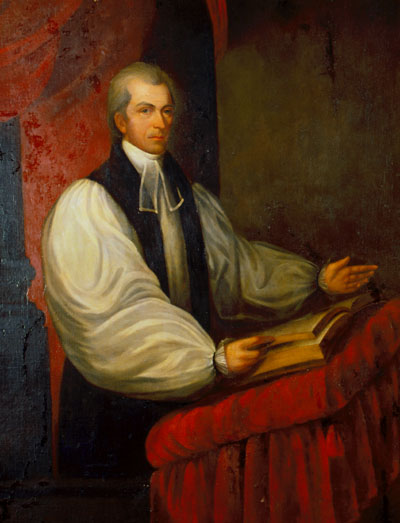James Madison, Bishop
| The Right Reverend Dr. | |
| James Madison | |
| Bishop, Episcopal Diocese of Virginia | |
| In office | |
| 1790 – 1812 | |
| Preceded by | Inaugural holder |
| President, College of William & Mary | |
| In office | |
| 1777 – 1812 | |
| Preceded by | John Camm |
| Succeeded by | John Bracken |
| Personal details | |
| Born | August 27, 1749 |
| Died | March 6, 1812 |
| Relatives | John Madison (father) Agatha Strother (mother) James Madison, Jr. (cousin) |
James Madison (1749 – 1812) was president of the College of William & Mary from 1777 to 1812, first bishop of the Protestant Episcopal Church in Virginia, and a cousin of James Madison, Jr. (later the fourth President of the United States).
Bishop Madison attended the College of William & Mary, graduating with high honors in 1771. After studying with George Wythe, he was admitted to the bar but never chose to pursue a legal career. Instead, in 1773, he was elected professor of natural philosophy and mathematics at the college. After a brief stint in England to further his studies and seek ordination to the ministry of the Church of England, he returned to Williamsburg and his position as a professor at the college. In 1777, the Board of Visitors elected him president of the college, a position he would hold until his death. In 1779, he worked with Thomas Jefferson (then Governor of Virginia and a member of the college's Board of Visitors), to create the position of Professor of Law and Police at William & Mary.
Madison ardently advocated for his vision of the new United States as a “Republic of Virtue” created by God to implement “the divine principles of liberty, equality, and fraternity”. This vision, however, did not include the immediate abolition of slavery.[1]
Madison became President of the College of William & Mary during bleak financial times – the Revolutionary War had deprived the College of most of its income, which came from the British crown. Madison authorized the College to sell most of the slaves from a plantation it owned in order to raise funds and relocated the rest to the College’s campus. The College also hired out some of its slaves “for Tobacco[2] or other Country produce” . Madison assumed that the College’s slaves would try to escape to the British side during the war, so he relocated them to prevent that.[3]
Following the Revolution, Madison played an instrumental role in the reorganization of the Episcopal Church in Virginia and was elected bishop in 1790. The Episcopal Church of Virginia also benefited from slavery in the post-Revolutionary years; much of its income came from donations by parishioners, and most of those donations came from income derived from slave labor. Bishop Madison also personally owned slaves, as did the three bishops who succeeded him.[4]
One of his students, abolitionist Edward Coles, asked Madison how he could reconcile his lectures on equality and the rights of man with the continued existence of slavery; Madison admitted he could not, and stated that the United States could only tolerate slavery because it was already in place and would be difficult to eliminate. Madison expressed a strong hope to Coles that Virginia would abolish slavery, but the Bishop had no plans to free his slaves before then.[5]
Madison died on March 6, 1812 and was buried in the crypt below the Wren Chapel at the College of William & Mary.
After his death, a secret Bishop James Madison Society was formed at William & Mary, with the goal of improving the College through good work.
References
- ↑ Charles Crowe, "Bishop James Madison and the Republic of Virtue", The Journal of Southern History, 30, no. 1 (Feb. 1964): 59, 63-64.
- ↑ Promissory notes payable in tobacco were a common currency in Virginia at the time. Emily Jones Salmon and John Salmon, "Tobacco in Colonial Virginia", Encyclopedia Virginia.
- ↑ Jennifer Oast, Institutional Slavery (New York: Cambridge Univ. Press, 2016), 147-51.
- ↑ Diocese of Virginia Committee on Race and Reconciliation, Meet Me in Galilee… Beginning the Journey from Repentance to Reconciliation: A History of Racism and Race in the Diocese of Virginia (2012), 26-27.
- ↑ Ralph L. Ketcham, "The Dictates of Conscience: Edward Coles and Slavery", Virginia Quarterly Review, 36, no. 1 (Winter 1960): 47-48.
